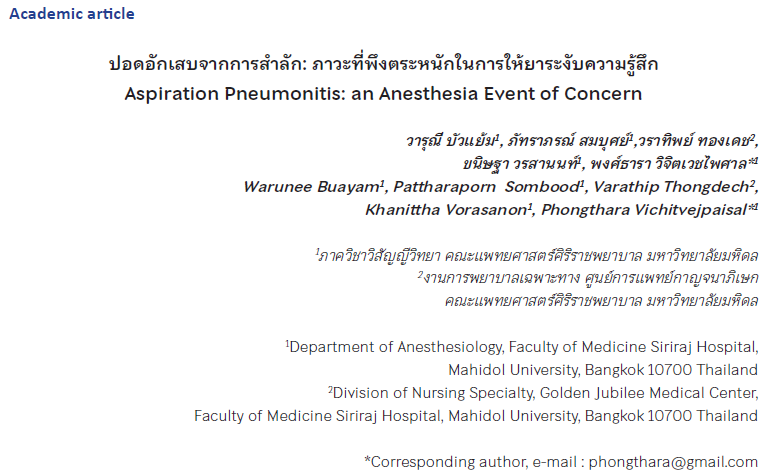Aspiration Pneumonitis: an Anesthesia Event of Concern
Keywords:
Anesthesia, Aspiration pneumonitis, Hypoxemia, Respiratory failureAbstract
Aspiration pneumonitis results from inadvertent dropping of water, gastric secretion or food particles into the respiratory tract, particularly the lungs. These foreign bodies stimulate the immune system, cytokines, leukocytosis and white blood cell aggregation as well as an inflammatory process, leading to intra-alveolar tissue damage. Subsequently, the ventilation and perfusion mismatch inevitably precedes severe hypoxemia and acute respiratory failure. The severity of signs and symptoms depends on the pH and the amount of aspirated particles, particulate or non-particulate. In anesthesia, aspiration pneumonitis represents an adverse event of concern during the administration of sedative or general anesthesia since all anesthetics alter patients’ limits of self-control and cause the digestive system to prolong gastric emptying time. The incidence could worsen during an emergency surgery. As a result, anesthesia personnel’s current focus is on prevention rather than cure, leveraging various integrated clinical practice guidelines, such as preoperative patient management, preoxygenation with high flow technique, endotracheal intubation, ventilation and consciousness stabilization. At present, the ultrasound method helps verify the characteristics of particles in the stomach just before anesthetic management because it can significantly cut down on aspiration pneumonitis incidences.
Downloads
References
Salik I, Doherty TM. Mendelson Syndrome. In: StatPearls. Treasure Island (FL): StatPearls Publishing; June 12, 2023.
Son YG, Shin J, Ryu HG. Pneumonitis and pneumonia after aspiration. J Dent Anesth Pain Med. 2017;17(1):1-12. doi:10.17245/jdapm.2017.17.1.1.
Charuluxananan S, Sriraj W, Punjasawadwong Y, et al. Perioperative and Anesthetic Adverse events in Thailand (PAAd Thai) incident reporting study: anesthetic profiles and outcomes. Asian Biomed. 2017; 11(1): 21-32. doi:10.5372/1905-7415.1101.535.
Binyamin Y, Orbach-Zinger S, Ioscovich A, et al. Incidence and Clinical Impact of Aspiration during Cesarean Delivery: A Multi-Center Retrospective Study. Anaesth Crit Care Pain Med. Accessed January 24, 2024. doi:10.1016/j.accpm.2024.101347
ปิยะภัทร เดชพระธรรม. ปัญหาการกลืนในผู้สูงอายุ (Dysphagia in Elderly). ASEAN J Rehabil Med.2556;23(3):73-80.
Gastroparesis. In: Wikipedia.; 2022. Accessed November 2, 2022. https://en.wikipedia.org/ w/index .php?title=Gastroparesis&oldid=1108933577
นปภัช ทองคำวงศ์. บทบาทพยาบาลในการประเมินและจัดการกับภาวะกลืนลำบากในผู้สูงอายุ (Nurses’ Role in Assessment and Management of Dysphagia in the Elderly). APHEIT J.2560;6(1):92-99.
Srivilai S, Pinyopasakul W, Charoenkitkarn V. Aspiration pneumonia prevention in patients with acute stroke: Evidence-based nursing practice.TJN. 2014;63(3): 65-71. https://he02.tci thaijo.org/index.php/TJN/article/ view/47043.
รัฐพล อุปลา. การสำลักสิ่งแปลกปลอมในทางเดินหายใจเด็ก.วารสารวิจัยมหาวิทยาลัยขอนแก่น. 2557;19(6): 950-956. จาก http://resjournal.kku.ac.th.
Velayutham P, Irace AL, Kawai K, et al. Silent aspiration: Who is at risk?. Laryngoscope. 2018;128(8):1952-1957. doi:10.1002/lary.27070.
Zheng Z, Wu Z, Liu N, et al. Silent aspiration in patients with exacerbation of COPD. Eur Respir J. 2016; 48(2): 570-573. doi: 10.1183/13993003.00007-2016.
Sanivarapu RR, Gibson J. Aspiration Pneumonia. In: StatPearls. Treasure Island (FL): StatPearls Publishing; May 8, 2023.
Bassam SA, Zaghw A, Khan MJ, et al. Airway Management in Full Stomach Conditions. In: Special Considerations in Human Airway Management. IntechOpen; 2020. doi.10.5772/intechopen.93591.
Sun J, Wei G, Hu L, Liu C, Ding Z. Perioperative pulmonary aspiration and regurgitation without aspiration in adults: a retrospective observational study of 166,491 anesthesia records. Ann Palliat Med. 2021;10(4):4037-4046. doi:10.21037/apm-20-2382.
Robinson M, Davidson A. Aspiration under anaesthesia: risk assessment and decision-making. Contin Educ Anaesth Crit Care Pain. 2013;14(4):171–175. doi:10.1093/bjaceaccp/mkt053.
Košutova P, Mikolka P. Aspiration syndromes and associated lung injury: incidence, pathophysiology and management. Physiol Res. 2021;70(Suppl4):S567-S583. doi:10.33 549/physiolres.934767
Tangwiwat S. Preoperative or Pre-procedural Fasting Guidelines in Patients Undergoing Elective Surgery and Procedures by the Royal College of Anesthesiologists of Thailand. Thai J Anesthesiol. 2021;47(4):380-387.
López Muñoz AC, Busto Aguirreurreta N, Tomás Braulio J. Preoperative fasting guidelines: an update. Guías de ayuno preoperatorio: actualización. Rev Esp Anestesiol Reanim. 2015;62(3):145-156. doi:10.1016/j.redar. 2014.09.006
Flynn DN, Doyal A, Schoenherr JW. Gastric ultrasound. In: StatPearls. Treasure Island (FL): StatPearls Publishing; February 20, 2023.
Zdravkovic M, Berger-Estilita J, Kovacec JW, Sorbello M, Mekis D. A way forward in pulmonary aspiration incidence reduction: ultrasound, mathematics, and worldwide data collection. Braz J Anesthesiol Elsevier. 2023;73(3):301-304. doi:10.1016/ j.bjane.2021.05.004
Chaney B, Brady MF. Sellick Maneuver. In: StatPearls. Treasure Island (FL): StatPearls Publishing; January 29, 2023.
Warner MA, Meyerhoff KL, Warner ME, Posner KL, Stephens L, Domino KB. Pulmonary Aspiration of Gastric Contents: A Closed Claims Analysis. Anesthesiology .2021;135(2):284–291. doi: 10.1097/ALN.0000000 000003831.
Ledowski T, Szabó-Maák Z, Loh PS, et al. Reversal of residual neuromuscular block with neostigmine or sugammadex and postoperative pulmonary complications: a prospective, randomised, double-blind trial in high-risk older patients. Br J Anaesth. 2021;127(2):316-323. doi:10.1016/j.bja.2021.04.026.

Downloads
Published
How to Cite
Issue
Section
License
Copyright (c) 2024 Chulabhorn Royal Academy

This work is licensed under a Creative Commons Attribution-NonCommercial-NoDerivatives 4.0 International License.
Copyright and Disclaimer
Articles published in this journal are the copyright of Chulabhorn Royal Academy.
The opinions expressed in each article are those of the individual authors and do not necessarily reflect the views of Chulabhorn Royal Academy or any other faculty members of the Academy. The authors are fully responsible for all content in their respective articles. In the event of any errors or inaccuracies, the responsibility lies solely with the individual authors.


